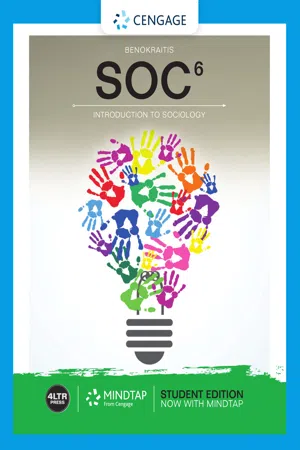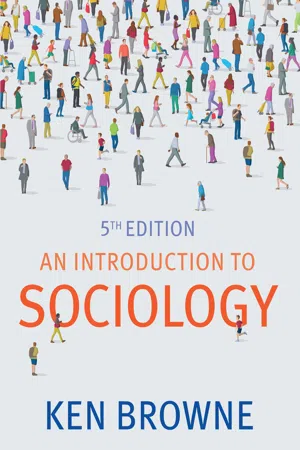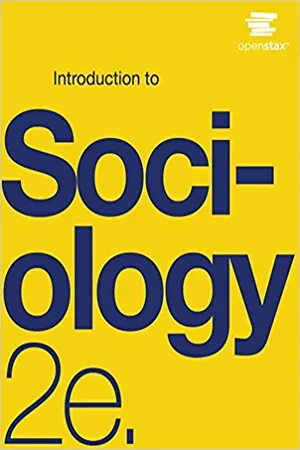Social Sciences
Global Stratification
Global stratification refers to the hierarchical arrangement of individuals and groups within a global context based on factors such as wealth, power, and access to resources. It encompasses the unequal distribution of economic opportunities, social privileges, and political influence among different countries and regions. This concept highlights the disparities and inequalities that exist on a global scale.
Written by Perlego with AI-assistance
Related key terms
1 of 5
8 Key excerpts on "Global Stratification"
- eBook - PDF
- Diana Kendall(Author)
- 2020(Publication Date)
- Cengage Learning EMEA(Publisher)
In this chapter we examine Global Stratification and inequality and discuss sociological perspectives that have been developed to explain the nature and extent of this problem. Before reading on, test your knowledge of global wealth and poverty by taking the “Sociology and Everyday Life” quiz. ● Wealth and Poverty in Global Perspective What do we mean by Global Stratification? Global Stratification refers to the unequal distribution of wealth, power, and prestige on a global basis, resulting in people having vastly different lifestyles and life chances both within and among the nations of the world. Just as the United States is divided into classes, the world is divided into unequal seg- ments characterized by extreme differences in wealth and poverty. For example, a major geographical imbalance exists in the distribution of household wealth between North America and Latin America, India, and Africa when you consider the share of the adult population in percentages as compared to the share of total wealth in each region. As reported by Credit Suisse’s Research Institute (2019): North America and Europe together account for 57% of total household wealth but contain only 17% of the world adult population. The two regions had similar total wealth at one time, but North America now accounts for 32% of global wealth compared to 25% for Europe. Elsewhere, the share of wealth is below G How does poverty affect the educational opportunities of children in poor countries such as Zimbabwe? Mark Ashe/ZUMA Press/New York/New York/U.S./Newscom moved out of poverty, and eventually became Camfed’s executive director. Copyright 2021 Cengage Learning. All Rights Reserved. May not be copied, scanned, or duplicated, in whole or in part. Due to electronic rights, some third party content may be suppressed from the eBook and/or eChapter(s). Editorial review has deemed that any suppressed content does not materially affect the overall learning experience. - eBook - PDF
- Tonja R. Conerly, San Jacinto College, Kathleen Holmes, Northern Essex Community College, Asha Lal Tamang, North Hennepin Community College(Authors)
- 2021(Publication Date)
- Openstax(Publisher)
Due to mechanical inventions and new means of production, people began working in 9.3 • Global Stratification and Inequality 249 factories—not only men, but women and children as well. By the late nineteenth and early twentieth centuries, industrial technology had gradually raised the standard of living for many people in the United States and Europe. The Industrial Revolution also saw the rise of vast inequalities between countries that were industrialized and those that were not. As some nations embraced technology and saw increased wealth and goods, the non- industrialized nations fell behind economically, and the gap widened. Sociologists studying Global Stratification analyze economic comparisons between nations. Income, purchasing power, and wealth are used to calculate Global Stratification. Global Stratification also compares the quality of life that a country’s population can have. Poverty levels have been shown to vary greatly across countries. Yet all countries struggle to support the lower classes. Models of Global Stratification FIGURE 9.12 Luxury vacation resorts can contribute to a poorer country’s economy. This one, in Jamaica, attracts middle and upper-middle class people from wealthier nations. The resort is a source of income and provides jobs for local people. Just outside its borders, however, are poverty-stricken neighborhoods. (Credit, both photos: Gail Frederick/flickr) In order to determine the stratification or ranking of a country, economists created various models of Global Stratification. All of these models have one thing in common: they rank countries according to their economic status, often ranked by gross national product (GNP). The GNP is the value of goods and services produced by a nation’s citizens both within its boarders and abroad. Another system of global classification defines countries based on the gross domestic product (GDP), a country’s national wealth. - eBook - PDF
- Nijole Benokraitis(Author)
- 2018(Publication Date)
- Cengage Learning EMEA(Publisher)
© Photo Credit Here Social Stratification: United States and Global LEARNING OBJECTIVES After studying this chapter, you will be able to… 8-1 Explain and illustrate social stratification systems and bases. 8-2 Describe the U.S. class structure and explain how and why social classes differ. 8-3 Describe poverty and explain why people are poor. 8-4 Compare the different types of social mobility, describe recent trends, and explain what factors affect mobility. 8-5 Describe Global Stratification, its variations and consequences, and the theoretical models that explain why inequality is universal. 8-6 Compare and evaluate the theoretical explanations of social stratification. After finishing this chapter go to PAGE 158 for STUDY TOOLS 8 GMB Akash/Panos SOC 138 Copyright 2019 Cengage Learning. All Rights Reserved. May not be copied, scanned, or duplicated, in whole or in part. Due to electronic rights, some third party content may be suppressed from the eBook and/or eChapter(s). Editorial review has deemed that any suppressed content does not materially affect the overall learning experience. Cengage Learning reserves the right to remove additional content at any time if subsequent rights restrictions require it. W H AT D O YOU T H I N K? Americans who are poor just aren’t working hard enough. 1 2 3 4 5 6 7 strongly agree strongly disagree almost 36 million people are living as slaves across the globe. About 61 percent are in just five countries—India, China, Pakistan, Uzbekistan, and Russia—but modern slavery is also prevalent in parts of Africa, the Middle East, and Asia (Walk Free Foundation, 2014). In a caste system, a second type of closed strati- fication system, people’s positions are ascribed at birth and largely fixed. Their places in the hierarchy are primarily determined by inherited characteristics such as race, skin color, gender, family background, or nationality (see Chap- ter 5). - eBook - ePub
- Ken Browne(Author)
- 2019(Publication Date)
- Polity(Publisher)
- What is social stratification?
- Systems of stratification
- Social class stratification and inequality
- Gender stratification and inequality
- Ethnic stratification and inequality
- Age stratification and inequality
- Stratification, inequality and disability
- Religion and sexuality as dimensions of inequality
- Stratification and inequalities in power and authority
- Poverty
THE SIGNIFICANCE OF SOCIAL INEQUALITYSocial inequalityrefers to the unequal access people have to resources such as wealth, income, power and status, and to the unequal distribution of opportunities linked to these, such as in education, health, housing and employment.Social inequality The unequal access people have to resources such as wealth, income, power and status, and the unequal distribution of opportunities linked to these, such as in education, health, housing and employment.Most people would agree that few societies are really equal. The study of social inequality is of central concern to sociologists because modern societies display such a wide range of inequalities. These include inequalities between rich and poor, between social classes, between men and women, between ethnic groups, and between age groups. Inequalities exist in a wide range of areas of social life, such as in job security, leisure opportunities, health, housing, income and the power to influence events in society. In Britain, income inequality – the gap between the rich and the poor – has grown rapidly since 1979, as shown in figure 6.1 , and the gap between the two groups is now one of the largest in comparison with the countries of the European Union.An understanding of social inequality provides a necessary starting point for the newcomer to sociology because it influences so deeply much of what happens in society.How inequality has grown in Britain, 1979–2017/18Figure 6.1Figure 6.1 shows how inequality has risen in Britain between 1979 and 2017–18. It is based on an index of inequality called the Gini coefficient. This shows income inequality on a scale of 0 (perfect equality - when everyone has the same income) to 100 (perfect inequality – when all income goes to only one person). The higher the figure, the more unequal a country is. In Britain in 1979, the Gini coefficient was 25.3, and in 2017–18, it was 34. There was a particularly large increase between 1979 and 1991, and inequality in 2017–18 was 34 per cent higher than it was in 1979. - eBook - PDF
- Heather Griffiths, Nathan Keirns, Eric Strayer, Susan Cody-Rydzewski, Gail Scaramuzzo, Tommy Sadler, Sally Vyain, Jeff Bry, Faye Jones(Authors)
- 2015(Publication Date)
- Openstax(Publisher)
These people make the decisions and earn the most money. The majority of Americans will never see the view from the top. (Photo courtesy of Alex Proimos/flickr) 184 Chapter 9 | Social Stratification in the United States This OpenStax book is available for free at http://cnx.org/content/col11762/1.6 Sociologists use the term social stratification to describe the system of social standing. Social stratification refers to a society’s categorization of its people into rankings of socioeconomic tiers based on factors like wealth, income, race, education, and power. You may remember the word “stratification” from geology class. The distinct vertical layers found in rock, called stratification, are a good way to visualize social structure. Society’s layers are made of people, and society’s resources are distributed unevenly throughout the layers. The people who have more resources represent the top layer of the social structure of stratification. Other groups of people, with progressively fewer and fewer resources, represent the lower layers of our society. Figure 9.3 Strata in rock illustrate social stratification. People are sorted, or layered, into social categories. Many factors determine a person’s social standing, such as income, education, occupation, as well as age, race, gender, and even physical abilities. (Photo courtesy of Just a Prairie Boy/ flickr) In the United States, people like to believe everyone has an equal chance at success. To a certain extent, Aaron illustrates the belief that hard work and talent—not prejudicial treatment or societal values—determine social rank. This emphasis on self-effort perpetuates the belief that people control their own social standing. However, sociologists recognize that social stratification is a society-wide system that makes inequalities apparent. While there are always inequalities between individuals, sociologists are interested in larger social patterns. - eBook - PDF
Political Economy and Sociolinguistics
Neoliberalism, Inequality and Social Class
- David Block(Author)
- 2018(Publication Date)
- Bloomsbury Academic(Publisher)
I harbour no such doubts and as I have here the space for such conceptual development and I feel it necessary to provide it, I do just this. In this sense, I continue along the same lines as in Chapters 2 and 3, as I set up and carry on a theoretical discussion of stratification, inequality and class. 76 POLITICAL ECONOMY AND SOCIOLINGUISTICS 76 Stratification In her monograph titled Stratification: Social Vision and Inequality , Wendy Bottero (2005) defines social stratification as follows: Social stratification is concerned with the patterning of inequality and its enduring consequences on the lives of those who experience it All of us live within pre-existing relations of unequal power, status or economic resources; and these unequal relations surround and constrain us, pro-viding the context of our interactions, inevitably affecting the choices we make in life, opening some channels of opportunity, and closing off others. This is a condition of social life (individual choice is always limited by the choices of those around us), but stratification is concerned with how some have more freedom and choice than others. . . . The point of stratification analysis is to see how such inequalities persist and endure – over lifetimes and between generations. (Bottero, 2005: 3) Important here is Bottero’s position that the study of stratification is about how social division and inequality exist in long-term form, although their continu-ous reproduction is the here and now in the form of activities taking place ‘at any given point in time’. In parallel to this temporal dimension there is the fact that stratification is, in effect, a ‘big structure’, which shapes local and surface- level activity without being reducible to it, from an analytical perspective. - eBook - PDF
Cultural Anthropology
An Applied Perspective
- Gary Ferraro, Susan Andreatta(Authors)
- 2017(Publication Date)
- Cengage Learning EMEA(Publisher)
Some people—and entire groups of people— have little or no access to the basic resources of the societies. Various groups in stratified societies, then, are noticeably different in social position, wealth, lifestyle, access to power, and standard of living. The unequal access to rewards found in stratified societies is gener-ally inheritable from one generation to the next. Although distinctions in wealth, power, and prestige began to appear in the early Neolithic period (approxi-mately 10,000 years ago), the emergence of truly strati-fied societies is closely associated with the rise of civiliza-tion approximately 5,500 years ago. A basic prerequisite for civilization is a population with a high degree of role specialization. As societies become more specialized, the system of social stratification also becomes more com-plex. Different occupations or economic interest groups do not have the same access to wealth, power, and pres-tige but rather are ranked relative to one another. As a general rule, the greater the role specialization in a society, the more complex is its system of stratification. Class versus Caste Social scientists generally recognize two different types of stratified societies: those based on class and those based on caste . The key to understanding this funda-mental distinction is social mobility . In class systems, a certain amount of upward and downward social mobility exists. In other words, individuals can change their social position dramatically within a lifetime. Individuals, through diligence, intelligence, and good luck, could go from rags to riches; conversely, people born to millionaire parents could wind up as home-less street people (Newman 1988). Caste societies, on the other hand, have little or no social mobility. Membership in a caste is determined by birth and lasts throughout one’s lifetime. - eBook - PDF
- Ruth Wodak, Barbara Johnstone, Paul E Kerswill, Ruth Wodak, Barbara Johnstone, Paul E Kerswill(Authors)
- 2010(Publication Date)
- SAGE Publications Ltd(Publisher)
Brainstorming about potential interdis-ciplinary avenues in the study of stratification inevitably raises more questions than answers. SOCIAL STRATIFICATION 97 At the same time, given the inherently complex social and linguistic dynamics of contemporary global societies, sociolinguists must increasingly reach across disciplinary boundaries. By joining forces with sociologists and other like-minded scholars to cultivate further the territory of social stratification research, sociolinguists may exam-ine in new and interdisciplinary ways how pat-terns of language variation and change, literacy, language attitudes and more are intertwined in systems of inequality within and across societies. REFERENCES Acker, J. (1973) ‘Women and social stratification: a case of intellectual sexism’, American Journal of Sociology, 78: 936–45. Acker, J. (1988) ‘Class, Gender, and the Relations of distribu-tion’, Signs, 13: 473–97. Acker, J. (2006) Class Questions: Feminist Answers . New York: Rowman and Littlefield. Anthias, F. (2001) ‘The material and the symbolic in theorizing social stratification’, British Journal of Sociology, 52: 367–90. Baugh, J. (2007) ‘Linguistic contributions to the advancement of racial justice within and beyond the African diaspora’, Language and Linguistics Compass, 1: 331–49. Bettie, J. (2003) Women Without Class: Girls, Race, and Identity . Berkeley, CA: University of California Press. Blau, P. M. and Duncan, O. D. (1967) The American Occupational Structure . New York: Free Press. Bonfiglio, T. P. (2002) Race and the rise of standard American . Berlin: Mouton de Gruyter. Bourdieu, P. (1984) Distinction: A Social Critique of the Judgement of Taste . President and Fellows of Harvard University Press and Routledge and Kegan Paul, Ltd. Bourdieu, P. (1986) ‘The forms of capital’, in A. H. Halsey, H. Lauder, P. Brown and A. S. Wells (eds), Education: Culture, Economy, and Society. Oxford: Oxford University Press. pp. 46–68. Bourdieu, P.
Index pages curate the most relevant extracts from our library of academic textbooks. They’ve been created using an in-house natural language model (NLM), each adding context and meaning to key research topics.







